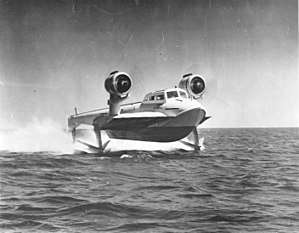Experimental Craft Hydrofoil No. 4 (XCH-4)
 USS XCH-4 underway | |
| History | |
|---|---|
| Builder: | Dynamic Developments Inc. |
| General characteristics | |
| Displacement: | 16,000 lbs |
| Length: | 53 ft (16 m) |
| Beam: | 32 ft (9.8 m) |
| Propulsion: | 2 Pratt and Whitney R-985 450 hp each |
| Speed: | Maximum 78 knots (foil-borne) |
The Experimental Craft Hydrofoil No. 4 (XCH-4) was a high speed hydrofoil of the United States Navy. In 1947 the Bureau of Ships in association with the Office of Naval Research subsidised the construction of a number of small watercraft to explore several different types of foils and foil control-system configurations. The XCH-4 (sometimes referred to as "The Carl Boat") was designed by John H. Carl and built, in 1953, by Dynamic Developments Inc., a former associate of the Grumman Aircraft Engineering Corporation.[1][2]
The XCH-4 employed three struts with "ladder" type hydrofoils. The foils were swept back approximately 45 degrees and have considerable dihedral providing a very stable ride even in moderately rough seas. The design eliminated drag inducing water propeller drive systems in favor of aircraft type propellers powered by two Pratt & Whitney R-985 Wasp Junior radial engines and in 1955 the vessel set a world speed record 78 knots.[3][4]
See also
- HD-4
- HMCS Bras d'Or (1919), auxiliary minesweeper (1939–1940)
- Bras d'Or (R-103), experimental hydrofoil (1957–1962)
References
- ↑ Walker, C. Lester (Feb 1961). "Ships That Fly on Wings". Popular Mechanics. Retrieved April 14, 2018.
- ↑ Armagnac, Alden P. (July 1961). "Seagoing Hydrofoils Do 60 Knots". Popular Science. Retrieved April 14, 2018.
- ↑ Palmer, Irwin. "Gas Turbines in Hydrofoil Seacraft". THE AMERICAN SOCIETY OF MECHANICAL ENGINEERS (62-GTP-4): 1–2. Retrieved April 15, 2018.
- ↑ Harris, Robert B. (June 1958). "Hydrofoil Craft" (PDF). The Amateur Yacht Research Society. Retrieved April 14, 2018.